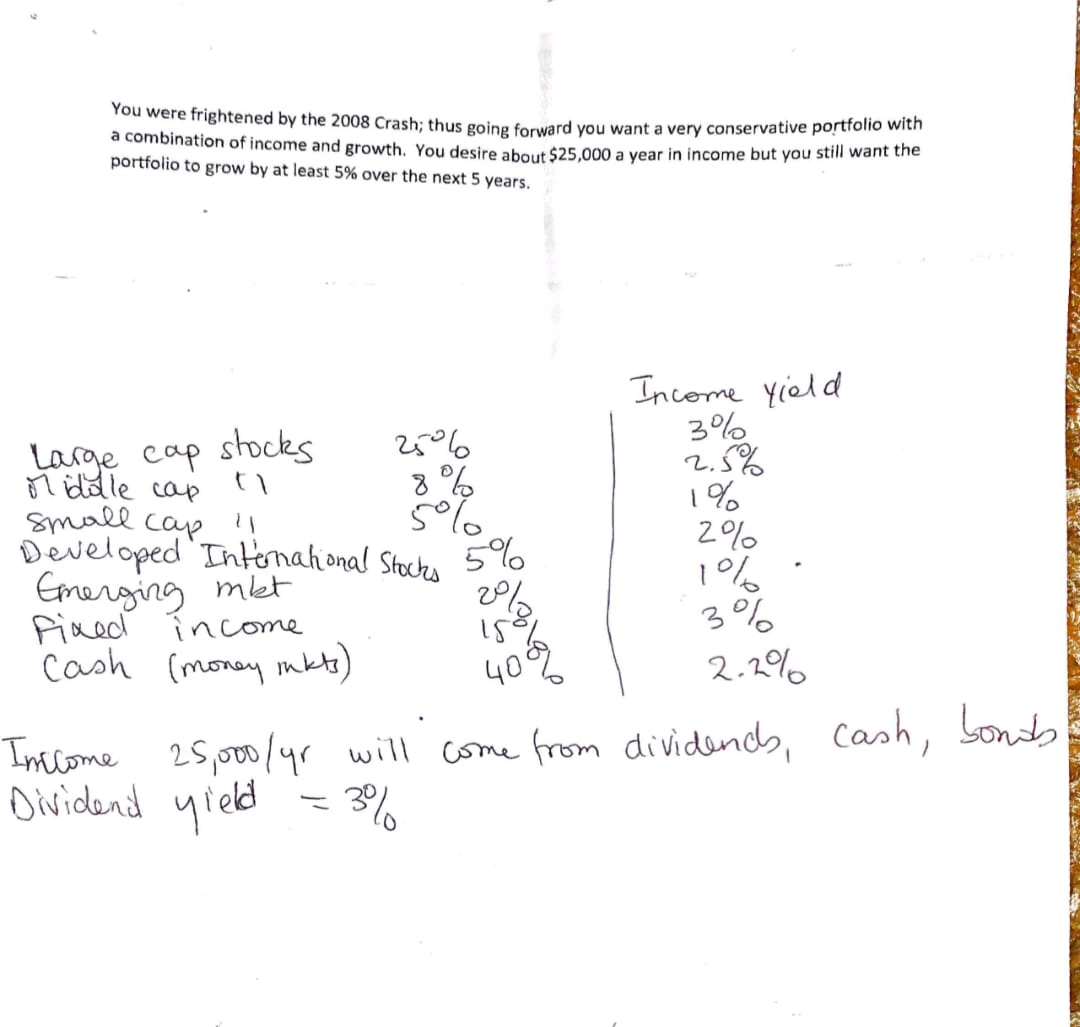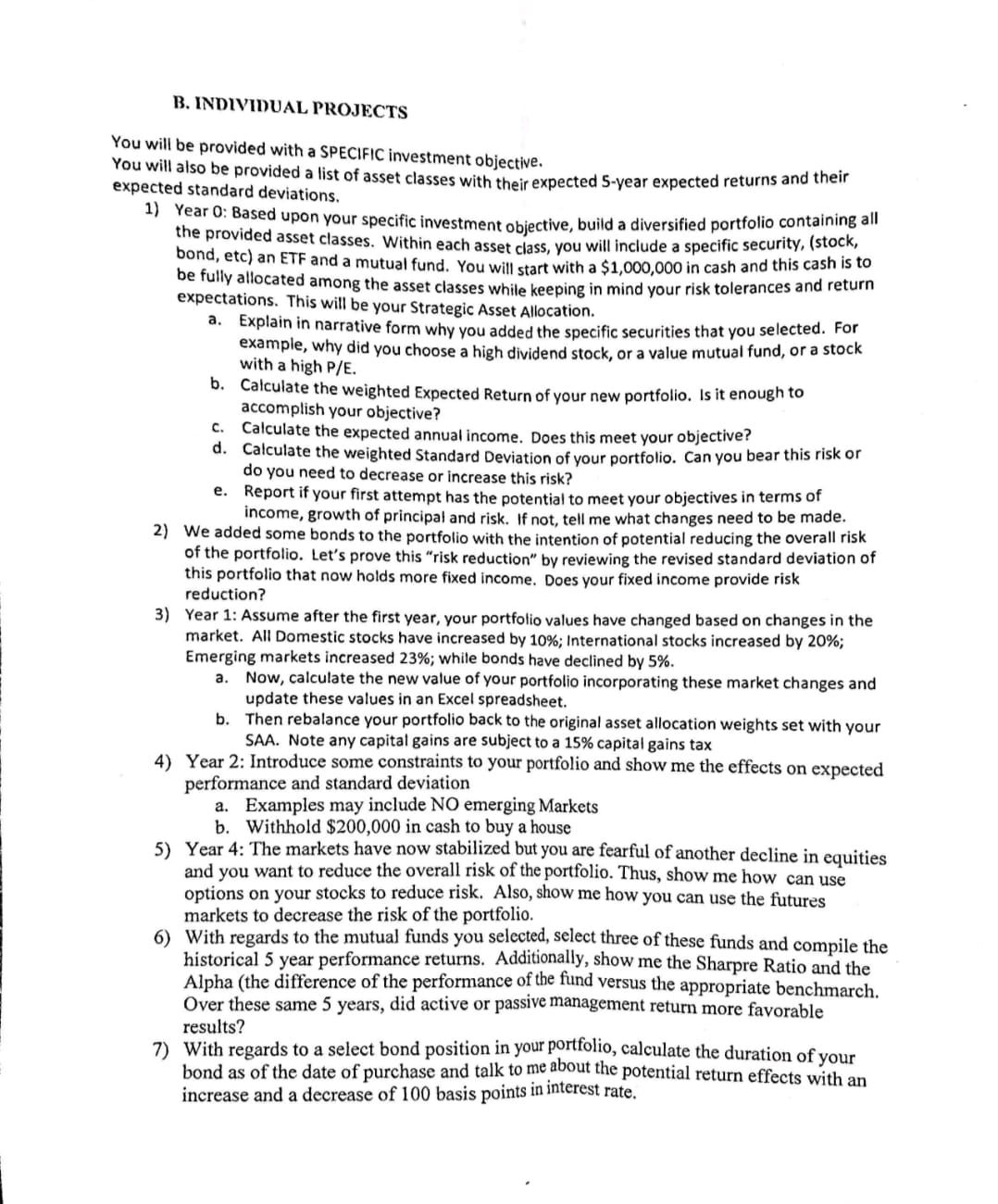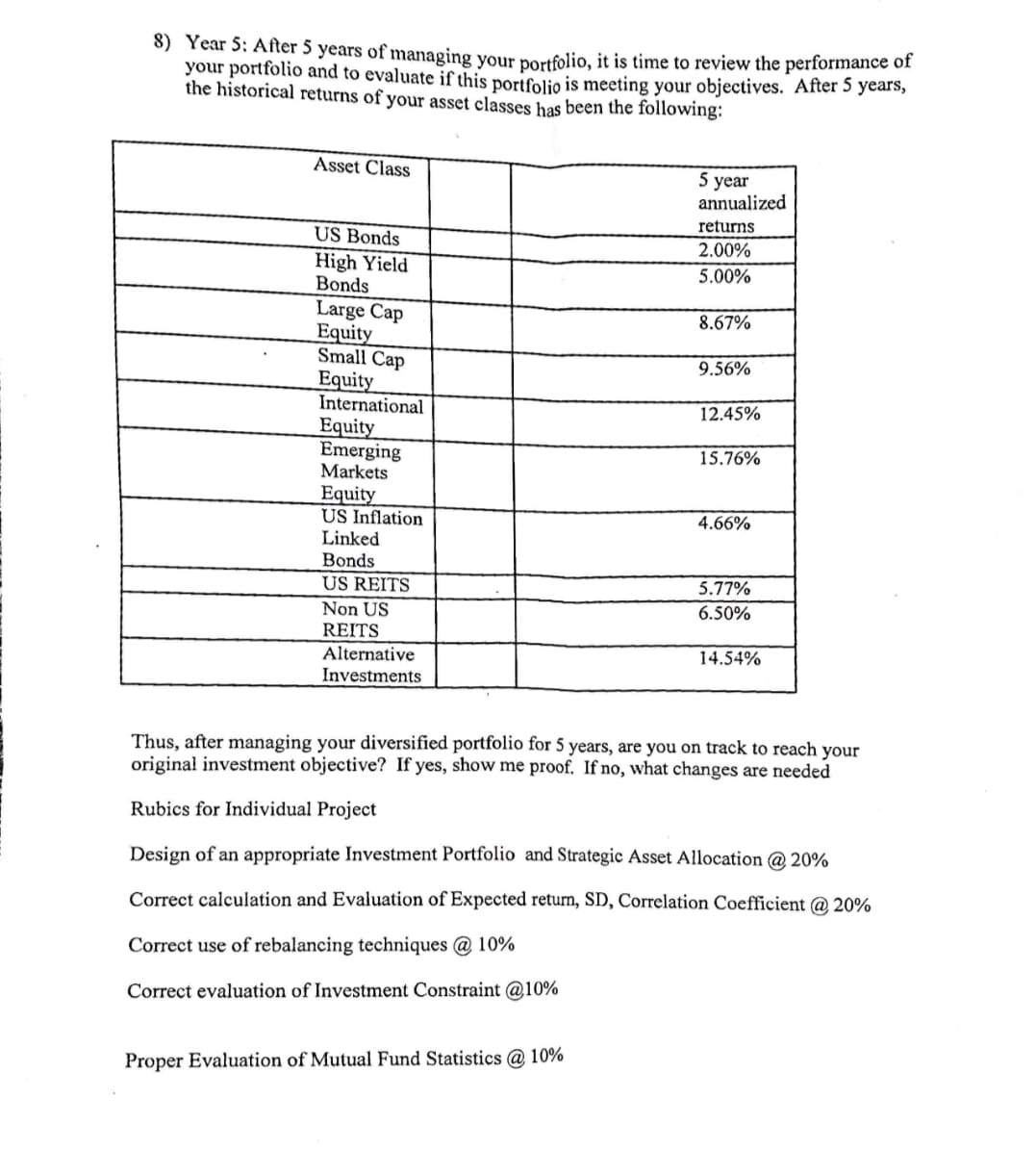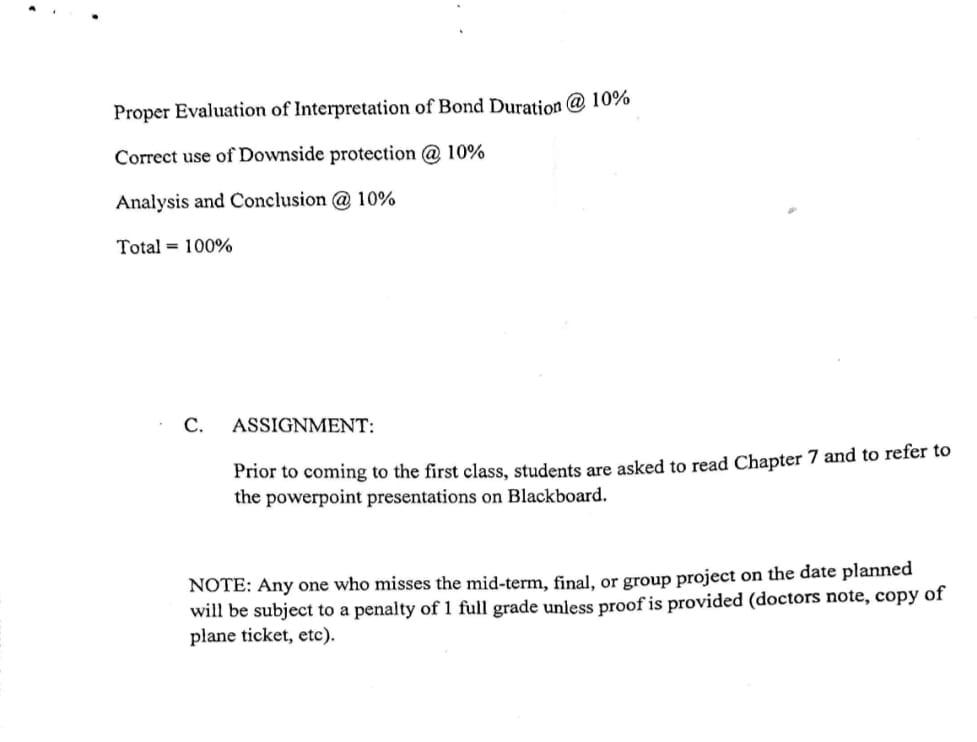QUESTION




ANSWER
1)
The investment objective is to make a moderately aggressive portfolio which can provide an annual gain of 5% and at the same time has an annual income of $25,000 per year. The income target is high and thus the portfolio will give importance to the income from different sources while selecting the asset classes. The annualised returns provided are assumed to be benchmark gains of each class. The income per asset and the rational of choosing a few specific income values is given in the excel itself.
Following are the stock weights that have been allocated. The allocation has been done keeping the perceived level of risk from any asset class and the aim of net income per year. Each security from the asset class should be able to give the required return of 5%.
| Asset Class | Security | Allocation |
| US bonds | US 10 Year T Bond |
20% |
| High Yield Bonds | BlackRock High Yield Bond Fund (BHYIX) |
10% |
| Large Cap Equity | Amazon.com |
20% |
| Small Cap Equity | Russel Investments – U.S. Small Cap Equity Fund |
10% |
| International Equity | iShares Core MSCI EAFE ETF |
10% |
| Emerging Markets Equity | HSBC Global Emerging Markets Fund |
10% |
| US Inflation Linked Bonds | Treasury Inflation-Protected Securities |
5% |
| US REITS | Vanguard Real Estate ETF (VNQ) |
5% |
| Non US REITS | Vanguard Global ex-U.S. Real Estate Index Fund ETF |
5% |
| Alternative Investments | JPMorgan Hedged Equity A |
5% |
- 10 Year Treasury Bills: The most stable form of investment which can provide a constant income. These bonds will also provide a cushion against the fluctuation of the stock market
- BlackRock High Yield Bond Fund (BHYIX): The fund has $15.12 billion in AUM of which 77% is invested in corporate bond. As this investment is in a fund, the investors’ confidence in more in the management capabilities of BlackRock when compared to the bonds itself.
- Amazon.com: The stock price has seen a constant growth and the company is venturing more in international markets. With the stability of a large cap company, the stock also has the aggression of a start-up in international markets.
- Russel Investments – U.S. Small Cap Equity Fund: Small cap equity brings risk to the portfolio. A mutual fund will be able to reduce that risk. The fund shows a short term capital gain of 0.8372. The fund has been operational since December 1981 which shows that the fund managers are chosen prudently.
- iShares Core MSCI EAFE ETF: The fund is chosen as it aligns itself towards MSCI and the index is a highly managed index which has shown great growth in recent years.
- HSBC Global Emerging Markets Fund: the fund itself operates out of one of the largest emerging market, China. The fund is benchmarked against MSCI EM and has been outperforming the same which shows great potential for growth given that MSCI EM itself has been growing more than 20% for last 10 years.
- Treasury Inflation-Protected Securities: The principal increases with inflation meaning that at maturity, bondholders are paid the inflation-adjusted principal which means that the money itself will be growing at a greater pace.
- Vanguard Real Estate ETF (VNQ): its primary goal is high income but there is gain in the value of the investment too. The fund tracks an index that measures the performance of REITs and is based against MSCI US REIT Index. The YTD returns of the fund are 17.89% with a yield of 3.96%.
- Vanguard Global ex-U.S. Real Estate Index Fund ETF: Vanguard itself is a pioneer in REIT investment funds and thus this was the right choice in case of non-US REIT fund as well.
- JPMorgan Hedged Equity A: With the YTD returns of 5.7% JP Morgan provides a much more stable option of an alternative investment fund compared to most of the funds.
The expected return of the portfolio is 7.98%. There is a buffer of approximately 3% to accomplish the objective of 5% growth in the portfolio. The expected income is 2.61% which at a base of $1,000,000 amounts to an annual income of $26,100. This is more than the income requirement.
As the covariance factors are not given the covariance between the different asset classes is assumed to be zero. In that case the standard deviation of the portfolio is 3.32% Even if the covariance among the classes is accounted for the standard deviation will not cross 7%. This should not be a problem and the return of 5% and income of $25,000 should easily cover for the risk.
The first attempt is able to meet all the overall requirements of the portfolio and there is no need to make any changes in the portfolio.
2)
To increase the fixed income the contribution of large cap and small cap equity in the portfolio was reduced ant the contribution of bonds and high yield bonds was increased. This change reduced the expected return from 7.98% to 7.24%. However the standard deviation of the portfolio was also reduced from 3.32% to 2.68%. Thus, the addition of fixed income has indeed provided risk reduction in the portfolio at a small expense of expected income.
3)
The following are the year-end values of the portfolio:
| Asset Class | Original Allocation | Change | New Value |
| US bonds | $ 2,00,000.00 | -5% | $ 1,90,000.00 |
| High Yield Bonds | $ 1,00,000.00 | -5% | $ 95,000.00 |
| Large Cap Equity | $ 2,00,000.00 | 10% | $ 2,20,000.00 |
| Small Cap Equity | $ 1,00,000.00 | 10% | $ 1,10,000.00 |
| International Equity | $ 1,00,000.00 | 20% | $ 1,20,000.00 |
| Emerging Markets Equity | $ 1,00,000.00 | 23% | $ 1,23,000.00 |
| US Inflation Linked Bonds | $ 50,000.00 | -5% | $ 47,500.00 |
| US REITS | $ 50,000.00 | 10% | $ 55,000.00 |
| Non US REITS | $ 50,000.00 | 10% | $ 55,000.00 |
| Alternative Investments | $ 50,000.00 | 10% | $ 55,000.00 |
The total value of the portfolio at the end of year is $1,070,500.00. The capital gain tax will be on $70,500 and will amount to $10,575. Thus the final portfolio value is $1,059,925. The original allocation weights have to be kept constant in the portfolio thus, the amount allocated will change according to the new portfolio value. Following are the new dollar allocations of the portfolio:
| Asset Class | Allocation | Dollar Allocation |
| US bonds | 20% | $ 2,11,985.00 |
| High Yield Bonds | 10% | $ 1,05,992.50 |
| Large Cap Equity | 20% | $ 2,11,985.00 |
| Small Cap Equity | 10% | $ 1,05,992.50 |
| International Equity | 10% | $ 1,05,992.50 |
| Emerging Markets Equity | 10% | $ 1,05,992.50 |
| US Inflation Linked Bonds | 5% | $ 52,996.25 |
| US REITS | 5% | $ 52,996.25 |
| Non US REITS | 5% | $ 52,996.25 |
| Alternative Investments | 5% | $ 52,996.25 |
A)
The following will be the portfolio detail if the constraint of no emerging markets is introduces in the portfolio:
| Asset Class | Allocation | Allocation Squared |
| US bonds | 20% | 4.00% |
| High Yield Bonds | 10% | 1.00% |
| Large Cap Equity | 20% | 4.00% |
| Small Cap Equity | 10% | 1.00% |
| International Equity | 20% | 4.00% |
| Emerging Markets Equity | 0% | 0.00% |
| US Inflation Linked Bonds | 5% | 0.25% |
| US REITS | 5% | 0.25% |
| Non US REITS | 5% | 0.25% |
| Alternative Investments | 5% | 0.25% |
| Expected Return | 7.65% | |
| Expected Income | 2.51% | |
| Standard Deviation | 3.51% |
The Emerging markets weight was moved to international equity fund. The expected return and income will decrease with the income staying just above the required levels. The standard deviation will also increase.
B)
Withholding $200,000 means that the weight of the portfolio will be reduced by 20%. Thus the risk will remain the same but the expected income and return (calculated over the base of $1000,000) will be at 80% of the original levels. Thus the following will be the results:
| Expected Return | 6.39% |
| Expected Income | 2.09% |
| Standard Deviation | 3.32% |
The expected return will still be high however the income will be below the required levels. The income based on the asset value at the end of Year 1 will be $22,131.23 which is approximately $3000 lower than the aim of the portfolio.
5)
Option to sell the stock at a given price (say 10% below the current prices) can be purchased. This way even if the stock value decreases by 20% the total decrease in the fund value will be limited to 10% of the stocks. With the initial allocation of 30% in large cap and small cap stocks combined, this limits the decrease in the fund value to just 3%.
In a similar way the futures market can be used to fix a selling price in the future. This completely eliminated the standard deviation of the asset which has been hedged with the futures market as the selling price and hence the final net gain for the portfolio is fixed. For example hedging the large cap stocks with the futures market will lower the standard deviation of the portfolio to 2.54%.
6)
The risk free rate is assumed to be 2.5% which is the 10 year bond yield currently. For Sharpe Ratio instead of the mean return the fund return has been used in case of the funds as that provides a much better base for calculation of a fund. The following are the results for the 3 funds:
| Russel Investments – U.S. Small Cap Equity Fund Class S | iShares Core MSCI EAFE ETF | BlackRock High Yield Bond Fund (BHYIX) | S&P 500 | |
| Mean Return | 0.06% | 0.08% | -0.13% | 9.46% |
| Fund Return | 6.08% | 2.78% | 4.33% | |
| Standard Deviation | 5.85% | 3.41% | 1.58% | 3.22% |
| Sharpe Ratio | 0.61145 | 0.082044 | 1.155667 | 2.161902 |
| Alpha | 0.050432 | 0.054375 | 0.095737 |
Active management did not return more favourable results than passive management. We can clearly see that S&P 500 has been outperforming the selected funds.
7)
The duration of the selected bond is 9.1 years as the bonds purchased are the ones that are just released. In the interest rate is increase by 100 basis points the returns of the bonds will decrease and vice versa.
8)
For the case of income the income of the fund would have remained constant and hence the income objectives should have been easily met. The annualised fund return after 5 years would be the same as the fund return calculated for the first year which was 7.98%. The details of the same are in the initial portfolio made in the excel sheet. Thus, the fund objectives have been met. The same would have been the case if the rebalanced portfolio was use after 1 year or the portfolio with no emerging market equity would have been used. However the portfolio where $200,000 had been cashed out, would not have been able to meet the requirements of income and there would have been a need to increase small cap stocks to increase income, keeping the returns constant. This would have increased the risk, however.
Looking for Finance Assignment Help. Whatsapp us at +16469488918 or chat with our chat representative showing on lower right corner or order from here. You can also take help from our Live Assignment helper for any exam or live assignment related assistance.